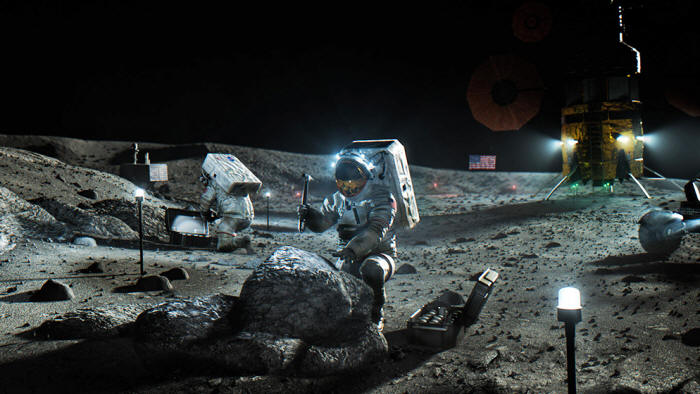|
This illustration made available by NASA in April 2020 depicts Artemis astronauts on the Moon. NASA via AP
A new space technology exploration program announced by the Defense Advanced Research Project Agency (DARPA) is riling up international opposition as the race to mine space heats up...
Far from indulging in apocalyptic visions of cosmic destruction, mining company executives like Bob Goldstein of US Nuclear Corp. were seeing dollar signs.
Goldstein and others in the resource extraction industry have been salivating over these otherworldly mineral prizes ever since Barack Obama signed the U.S. Commercial Space Launch Competitiveness Act into law, which grants U.S. citizens the right to own resources mined in space.
The bill, introduced and co-sponsored exclusively by Republican Congressmen, was passed by a unanimous vote in 2015.
Praised as a "landmark for American leadership in space exploration" by Congressman Bill Posey (R-FL), the Space Act of 2015, as it is also known, has elicited all manner of effusive reactions from private sector space industry giants like Planetary Resources, which had already struck a deal with Bechtel Corporation in 2013 to mine asteroids.
Planetary co-founder Eric Anderson declared that the legislation was nothing less than a,
Despite the Neil Armstrong-esque displays by both private and public sector players, the recent inclusion of the Defense Advanced Research Projects Agency (DARPA) into the conversation has many on the international space policy side of the equation worried.
NOM4D
The Novel Orbital and Moon Manufacturing, Materials and Mass-efficient Design (NOM4D) program announced by DARPA on February 5,
The language used to describe the program has sparked heated debate over whether or not NOM4D will violate Article IV of the United Nations Outer Space Treaty (OST), which prohibits the,
Chris Johnson, legal counsel of the Secure World Foundation - a private foundation that promotes space sustainability - clarified some of the ambiguity surrounding the debate in an email to Breaking Defense, stating that,
NOM4D program director manager Bill Carter dismisses such concerns, claiming to be "slightly baffled" by the controversy, asserting that the project is,
Carter, a materials scientist, elaborated about the areas of focus and highlighted the program's interest in,
The validity of Carter's arguments notwithstanding, his mention of regolith in particular buttresses Johnson's concerns.
The "dust-like material that covers the lunar surface" is considered a prime resource for the eventual construction of moon bases.
Something of a generic term used to describe the layer of,
...that form on the surface of solid rock, lunar regolith, by contrast, has its own unique composition.
As Johnson says, while,
The Opposition
Carter goes on to differentiate the activity DARPA will be engaging in from other space exploration initiatives which he believes exclude the program from the questions of policy it is being confronted with.
According to him, the "big difference" consists of DARPA's centering its effort around,
But, this also runs into problematic territory when taking the DoD's own position into consideration.
In his confirmation testimony, Biden's Secretary of Defense Lloyd J. Austin III, extolled Obama's "third offset" strategy, which explicitly cites robotics as one of the innovations to be fast-tracked through the public and private sector in order to secure the nation's technological edge in response to China and other threats.
Austin assured lawmakers that he would maintain a "laser-like focus" on countering the Chinese military threat and building "space-based platforms," while "repeatedly" stating that his department will consider space a war-fighting domain.
DARPA's program "is particularly tone deaf", according to Jessica West, a senior researcher at Canada's Project Ploughshares and the Space Security Index project.
She worries that the agency's project undermines the efforts of other international space organizations seeking to build a cooperative framework,
Other policy experts are warning that a "brewing space mining war" between the U.S., China, and Russia could lead to an unwinnable conflict that could indeed spell Armageddon for our own relatively tiny planet.
As Roscosmos' deputy general director for international cooperation, Sergey Saveliev stated on the occasion of Donald Trump's executive order to support mining on the moon,
|


